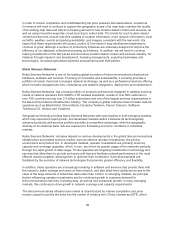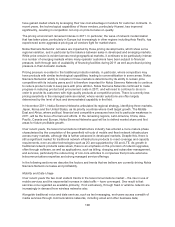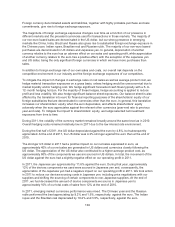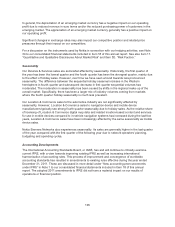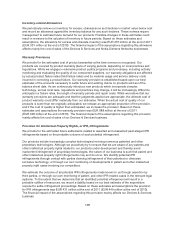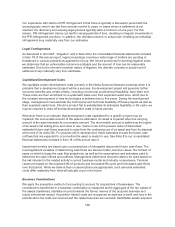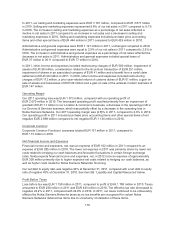Nokia 2011 Annual Report Download - page 111
Download and view the complete annual report
Please find page 111 of the 2011 Nokia annual report below. You can navigate through the pages in the report by either clicking on the pages listed below, or by using the keyword search tool below to find specific information within the annual report.Our experience with claims of IPR infringement is that there is typically a discussion period with the
accusing party, which can last from several months to years. In cases where a settlement is not
reached, the discovery and ensuing legal process typically lasts a minimum of one year. For this
reason, IPR infringement claims can last for varying periods of time, resulting in irregular movements in
the IPR infringement provision. In addition, the ultimate outcome or actual cost of settling an individual
infringement may materially vary from our estimates.
Legal Contingencies
As discussed in Item 8A7. “Litigation” and in Note 29 to the consolidated financial statements included
in Item 18 of this annual report, legal proceedings covering a wide range of matters are pending or
threatened in various jurisdictions against the Group. We record provisions for pending litigation when
we determine that an unfavorable outcome is probable and the amount of loss can be reasonably
estimated. Due to the inherent uncertain nature of litigation, the ultimate outcome or actual cost of
settlement may materially vary from estimates.
Capitalized Development Costs
We capitalize certain development costs primarily in the Nokia Siemens Networks business when it is
probable that a development project will be a success, the development project will generate further
economic benefits and certain criteria, including commercial and technical feasibility, have been met.
These costs are then amortized on a systematic basis over their expected useful lives, which due to
the constant development of new technologies is between two to five years. During the development
stage, management must estimate the commercial and technical feasibility of these projects as well as
their expected useful lives. Should a product fail to substantiate its estimated feasibility or life cycle, we
may be required to write off excess development costs in future periods.
Whenever there is an indicator that development costs capitalized for a specific project may be
impaired, the recoverable amount of the asset is estimated. An asset is impaired when the carrying
amount of the asset exceeds its recoverable amount. The recoverable amount is defined as the higher
of an asset’s net selling price and value in use. Value in use is the present value of discounted
estimated future cash flows expected to arise from the continuing use of an asset and from its disposal
at the end of its useful life. For projects still in development, these estimates include the future cash
outflows that are expected to occur before the asset is ready for use. See Note 8 to our consolidated
financial statements included in Item 18 of this annual report.
Impairment reviews are based upon our projections of anticipated discounted future cash flows. The
most significant variables in determining cash flows are discount rates, terminal values, the number of
years on which to base the cash flow projections, as well as the assumptions and estimates used to
determine the cash inflows and outflows. Management determines discount rates to be used based on
the risk inherent in the related activity’s current business model and industry comparisons. Terminal
values are based on the expected life of products and forecasted life cycle and forecasted cash flows
over that period. While we believe that our assumptions are appropriate, such amounts estimated
could differ materially from what will actually occur in the future.
Business Combinations
We apply the acquisition method of accounting to account for acquisitions of businesses. The
consideration transferred in a business combination is measured as the aggregate of the fair values of
the assets transferred, liabilities incurred towards the former owners of the acquired business and
equity instruments issued. Acquisition-related costs are recognized as expense in profit and loss in the
periods when the costs are incurred and the related services are received. Identifiable assets acquired
109


